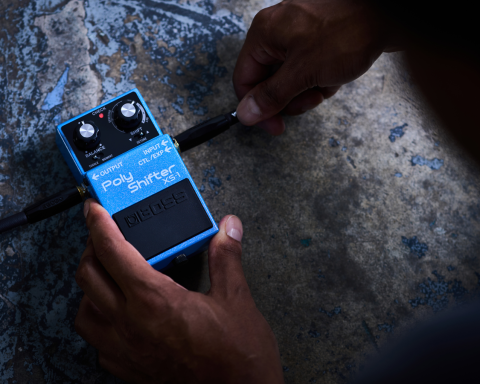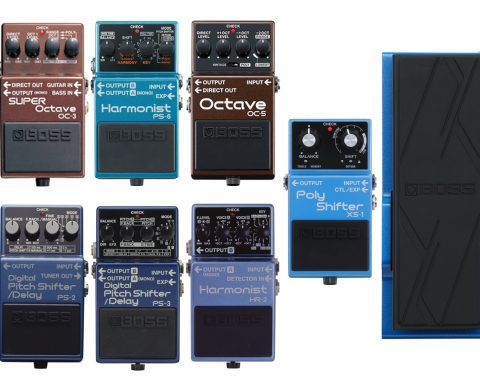The flanger has been a swirling presence in popular music throughout the decades. Musicians have used it to create everything from the seismic jet plane soundscapes of ’80s hard rock to the psychedelia of The Beatles’ “Tomorrow Never Knows.” It is a modulation effect famous for its powerful capabilities, but it can do so much more than that. Flanger can be a go-to pedal for countless situations, a one-stop shop for all a guitarist’s modulation needs. Learn to combine it with other effects for incredible results.
Flanger Placement
Like most modulation effects, flanger works best positioned after drives but before delays and reverbs. This placement allows the flanger to enhance drive effects by adding an extra texture to their tone—like a boost, but with added character. They work best before delays and reverbs not to overpower the other effects. If the flanger were to run into a delay, for example, it would squash and muddy the delay tails making them less impactful.
Famous Flange
Flanger may be an acquired taste, but it’s been a defining effect for more legendary riffs than most people realize. Listen to the opening notes of Heart’s rock n’ roll classic, “Barracuda,” to hear the cascading wave of flanger bring a simple chord pattern to life. The Cure’s “A Forest” is an equally outstanding use of the effect. Listen to the super slow atmospheric movement that flanger creates on Robert Smith’s rhythm guitar. The effect can breathe new life into the simplest of guitar parts.
PEDAL COMBINATIONS
Overdrive
Overdrive is arguably the most popular effect to combine with a flanger pedal like the BOSS BF-3. A driven guitar is a perfect platform for a flanger pedal’s soaring sonic jet plane tones. Paired with something like a BOSS SD-1, the overdrive’s pushed midrange accentuates the flanger’s cascading swirl.
Listen to Lenny Kravitz’s “Are You Gonna Go My Way” for a quintessential example of this pairing. The jagged ‘70s-inspired rock and roll progression gets drowned in a thick flanger that dominates the riff. To achieve this effect, set the flanger rate a little past 12 o’clock and the depth somewhere around the full rotation. Setting the depth at such an extreme will bring the flanger’s movement to the forefront of the tone.
Recommended Pairings
- BOSS BF-3 and SD-1
- BOSS BF-3 and BD-2W
Delay
Delay is a stellar effect for creating atmosphere in music. It works very effectively with straightforward guitar parts. A held chord with a rhythmic echo can occupy a lot of space and be more than enough to carry a song.
Using a flanger is an excellent way to excite the fading rhythmic repeats of a delay pedal. It can add depth and atmosphere while remaining subtle enough not to dominate the music. Andy Summers of The Police used flanger coupled with delay to significant effect to create precisely that. Listen to The Police’s “Walking On The Moon” for a lush example of an extremely simple guitar part excited and expanded by pairing these two effects.
"Using a flanger is an excellent way to excite the fading rhythmic repeats of a delay pedal."
In this example, Summers plays simple stabbed chords and lets the delay pedal’s repeats ring out. Adding a slow, unintrusive flanger creates a gentle movement to the part, like the slow warping of a record. Set the rate and depth controls relatively low to make this added texture. The flanger needs to be subtly present without being obvious. This approach with flanger can work in numerous ways with many other effects types. Flanger is often most effective when used subtly to lift a chord progression or picked part.
Recommended Pairings
- BOSS BF-3 and DD-8
- BOSS BF-3 and DD-500
Tremolo
Turn an electric guitar into a synthesizer with the simple pairing of tremolo and flanger. Traditionally, both effects work for a classic, organic guitar tone. However, pushed to their limits, they can turn a guitar into a science fiction ray gun.
Set the tremolo depth fully clockwise to create the most extreme level of chopping. Then set the speed relatively fast for an almost mechanical glitch to the guitar tone. Similarly, set the flanger depth fully clockwise, but set the rate no further than 12 o’clock. The heavily modulated swirl of the flanger paired with the robotic stutter of the tremolo transforms the tone. Try playing simple single-note progressions for unique, heavily modulated guitar tones.
Recommended Pairing
- BOSS BF-3 and TR-2
"Turn an electric guitar into a synthesizer with the simple pairing of tremolo and flanger."
Reverb
Reverb is a constantly evolving effects type. Traditional reverb sought to emulate the natural resonance of larger rooms to create the feeling of space and texture for guitar. By contrast, modern trends have moved to a more expansive, synthetic reverb type. Originally, reverb was intended to emulate real-world environments. Many musicians now use it to create an otherworldly soundscape of cavernous echos. Flanger is a perfect pedal partner for this application.
The jet-like swirls of a flanger set deep and slow can add texture and movement to a vast cavernous reverb. The pairing can be very effective for players who create substantial ethereal sonic waves. To create this type of effect, set the reverb pedal to a shimmer or octave-style preset, and maximize the time and effect level controls. Set the flanger rate around 9 o’clock for a nice, slow sweep, and set the depth to about 3 o’clock for a deep, focused modulation wave.
Recommended Pairing
- BOSS BF-3 and RV-6
"The jet-like swirls of a flanger set deep and slow can add texture and movement to a vast cavernous reverb."
Character and Movement
Flanger is a modulation effect that, like most modulation types, expands and excites the effects that it’s paired with. Its versatility remains underrated. Flanger can add character and movement to delays and reverbs, provide an extra splash of psychedelia to overdrives, and give the guitar a synth-like quality, perfect for players looking to expand their tones beyond the predictable.






